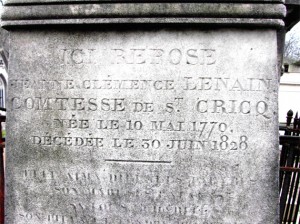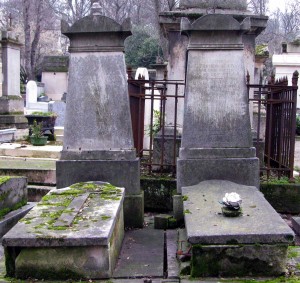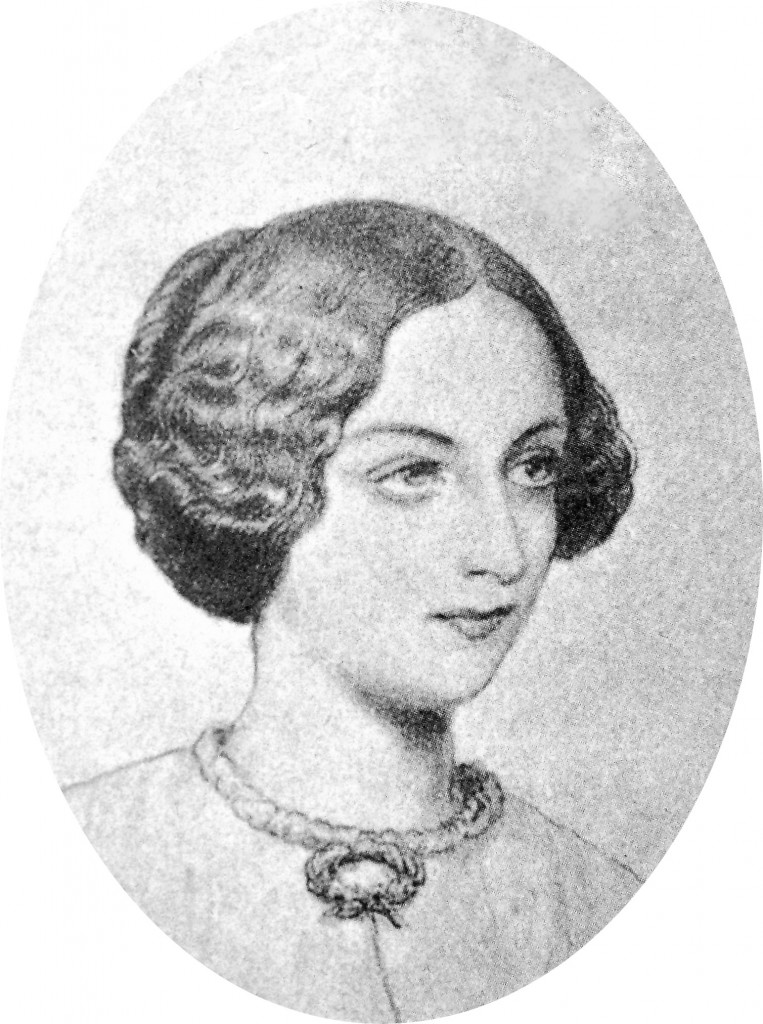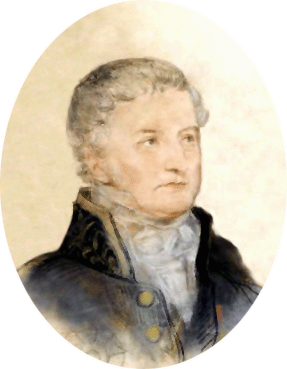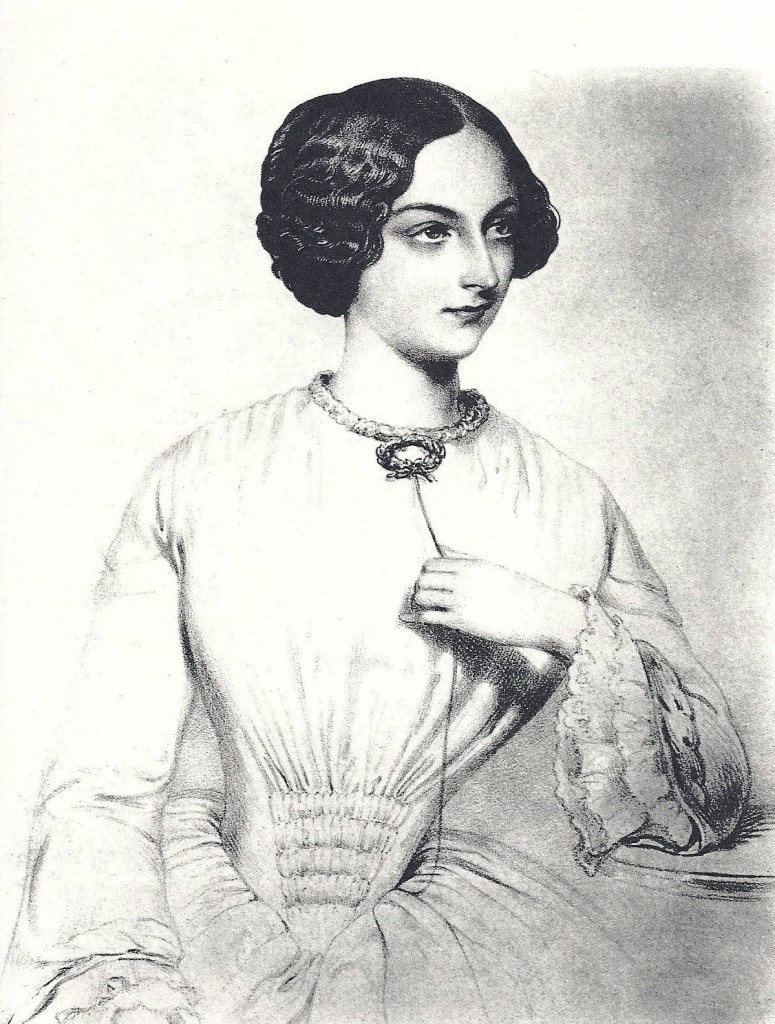Meet Caroline de Saint-Cricq and her family
Her Parents: Pierre and Clémence
Countess Caroline-Louise de Saint-Cricq was the daughter of Count Pierre-Laurent-Barthelemy-François-Charles de Saint-Cricq and Jeanne-Clémence Lenain de Tillemont.
Her father Pierre was born on August 24, 1772 in Orthez[1] in the Lower Pyrenees region, near Pau. He went to school at the Barnabites monastery in Lescar, outside Pau. His parents destined him for the priesthood, but the French Revolution changed this course and he moved to Paris to study at the university.
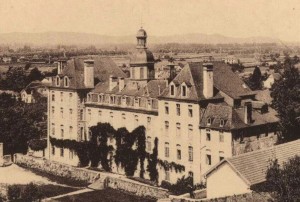 Barnabites monastery, Lescar, Pau (~1920)
Barnabites monastery, Lescar, Pau (~1920)
The name Saint-Cricq exists since the early middle ages. The family has a military background – Pierre’s father was a general – and gained wealthy estates in the Bearn region. They have been part of the French aristocracy for hundreds of years and several villages in the Bearn region have a Saint-Cricq connection. The family owned a small feudal castle near the centre of the town of Sus, some 40 km west of the city of Pau. Two fiefs of the Saint-Cricq family, Athos and Aramitz, became immortalized by Alexandre Dumas in his 1844 novel The Three Musketeers.
Pierre de Saint-Cricq was described as a constitutional leftist minister and became Commander of the Legion of Honor and Count on April 10, 1814, as well asMP[2] and Director of Customs in 1815. His career was further boosted by the marriage (on April 15, 1819) of King Charles X to Pierre’s niece, Marie-Antoinette de Saint-Cricq-Caseaux[3]. He expanded his responsibilities year by year in various roles, from being a member in the Assembly of the Lower-Pyrenees to that of Minister of Commerce and the Colonies for the King from Jan 4, 1828 to Aug 8, 1829. Pierre typically spent the winters in Paris and summers in Pau.
Pierre had a gift for words, and a talent for improvisation. He is depicted as a writer’s friend and a protector of the arts. During his career, he proved to be very flexible in his views, moving from left to right in the House of Parliament to maximize his career and family opportunities. Helping to move the French industry forward was of secondary importance to him, for which he received strong criticism. However, even his political opponents complimented him on his ability never to make a career blocking decision. This is how he managed to stay in office during the government of Charles X as well as during that of Louis-Philippe (until late1832). He became a Pair de France (equal to the monarch in honor) in 1833, an extraordinary honor only granted to few noblemen. After a long and successful career, Pierre withdrew back to his home town of Pau, where he continued discussing and influencing politics within a small circle of friends and managed his properties in the domains of Sus and Igon (near Betharram). He died[4] on February 25, 1854, at the respectable age of 81 years and was buried at Pau cemetery. According to the newspaper Memorial des Pyrénées[5], before passing away, he dictated some last instructions to Caroline, “with the cold-blooded air of someone who is used to taking care of his affairs before going on a journey”.
Alexandre Dumas described the Count of Saint-Cricq as “the first smuggler of the kingdom” in his anecdotal book Impressions de voyage[6]:
In an overzealous attempt to fight smuggling between France and Switzerland, the count personally went to Geneva [around 1815] and ordered jewelry for a sizable amount of money. He warned his customs officers to trace the routes of the smugglers taking the jewelry to Paris and deployed extra horses to make sure his customs officers could not be outrun. Arriving at his home, after spending a few moments to greet his family and to change out of his travelling clothes, he found the box of jewelry placed on the mantelpiece in his study. One of his servants told him that he had taken the box from the count’s own personal luggage, where it had been cleverly placed in Geneva by one of the servants of the jewelry store!
Jules Paulmier[7], one of the count’s subordinates, who had been passed over for promotion, depicted him as a greedy and unreliable villain. This last image is the one that Liszt biographers preferred.
Caroline’s mother was Jeanne-Clémence Lenain de Tillemont[8]. Like her husband she was of an ancient and respected wealthy aristocratic family, including parliamentarians, attorneys, a famous historian, and two painters. She was born on May 10, 1770 in Paris. Most biographers refer to her as a kind person with delicate health. With her death on June 30, 1828[9], Caroline lost the person who organized her life for her and who supported her closeness with young Liszt. This was not dissimilar to Liszt losing his father Adam Liszt ten months earlier. Clémence was buried at Père Lachaise cemetery in Paris (just behind Dulong’s obelisk).
Tombstone Caroline’s mother Clémence in Paris
Her Brothers: Jules, Alphonse, and Auguste
Count Pierre and Countess Clémence had four children: three sons and one daughter. I have provided details about them below as this offers an insight into the structure and activities of the Saint-Cricq family. History and books on the nobility, as well as Liszt biographers differ substantially on the brothers and/or sisters of Caroline. The quantity of errors in these historic documents is high: names of children from various family branches are mixed-up, and dates and/or places of birth are incorrect. After analyzing multiple sources [10] I conclude that four children were raised in the Saint-Cricq family. Pierre and Clémence may have had a total of five children, of which one may have died soon after birth. Their second son (Alphonse) died in early adolescence. Records from August 1809 of Lycée Napoléon in Paris indicate that, at the time, Jules was in fourth grade and Alphonse was in third grade.
The oldest son, Jules-Charles-Francois de Saint-Cricq [11] , was born on the Nonidi of the second decade of the month Ventôse in the Quatrième year. This French Republican calendar was installed after the revolution of 1792 and specifically designed to make the life of music history researchers more miserable. It translates to March 9, 1796. Jules was a bright boy who studied at the Lycée Napoléon in Paris where he won prices for Latin and Greek translation in 1809. La Revue de Paris wrote: Le 12 octobre 1807, le proviseur de Wailly proposait à Fourcroy pour une demi-bourse, en raison de ses succës au concours général, le jeune Jules-Charles de Saint-Cricq, fils du futur ministre de Charles X, alors chef de division à l’administration des douanes. Jules also studied the English language, and eventually became MP like his father. He was knighted on May 26, 1817 at the young age of twenty-one and married Hermine-Élisabeth Drouyn de Lhuys, daughter of a family of politicians, on her seventeenth birthday on April 15, 1819. Later that year, Jules de Saint-Cricq completed his book Notes d’Absence [12] about his extensive travels through Europe and North America and on his view of the French revolution, dedicating it to his younger brother Auguste. In his introduction to this book, Jules describes a letter that he received from his father in May/June 1818.
“[…] The idea is far from me that I should have, neither for this consideration nor for any other in the world, any complaints about a father whose life has been devoted to do good, who reminded me of happiness, to a happiness as pure as I have ever tasted, whose every action, every word was a blessing for me, and who also wrote me last year, in America:
<< O my excellent son, o my best friend, I have already slept 20 nights away from you and you may already have been separated 1500 leagues from your father. Like my Alphonse, when he surrendered to death, you followed an honorary mission. Ah! Let this one not cost me, like the the first, a son; every hour you are moving further away from your father who would shed his blood for you, and from a brother and a sister who will be, one day, I hope, worthy of you, and which mission brings you closer to a person who connects you to honor, for which I adore you even more passionately, but which maybe, until my death, put two thousand leagues of sea between my best friend and me. My beloved son, at least, exiled to the new world, tell yourself that God already terribly hurt me through Alphonse, and that He can not take anything else away from me without throwing me into an abyss of pain for which I am without force today.>>”
On March 4, 1820, the daughter of Jules and his wife Hermine, Marie-Mathilde-Julie-Hermine de Saint-Cricq, was born in Strasbourg. In early 1838, also at the age of seventeen, this daughter married her mother’s uncle, her fifteen-years older second -cousin Edouard Drouyn de Lhuys. Edouard was ambassador and later became senator and foreign minister [13]. The world of the upper class as small: Liszt had good contact with Drouyn de Lhuys in the 1840’s when Edouard assisted him to obtain travel permits for several foreign travels.
Jules’ relationship, via his wife and his daughter to the famous statesman Drouyn de Lhuys, moved his career forward. However, the high hopes that Jules set in his youth did not follow through; he became more and more eccentric and the subject of gossip by local newspapers [14] . One one occasion, Jules bought three balls of ice cream at a street shop and pocketed two to take home. Jules de Saint-Cricq died in a nursing institute in Vanvès, a suburb south of Paris, on his birthday, March 9, in 1871 [15]. Like his mother, he was buried at the Saint-Cricq tomb [16] at the Père Lachaise cemetery.
Tomb of Jules de Saint-Cricq (left side of his mother Clémence’s tomb
The second son of the Count and Countess was Alphonse-Jean-Paul de Saint Cricq. Given the fact that he was one class behind Jules, and with the knowledge that Jules went to school at an earlier age than his classmates, Alphonse probably was born mid-1797. I have not yet been able to find a birth certificate, which is surprising given that the certificates of his three siblings are present in the Paris archives. We do know that some parts of the archives did not survive the 1861 fire, but it may also be that Alphonse was not born in Paris. From the records of Lyée Napoléon we know he was still alive in summer 1809 at a probable age of 14. Given the strong references by Jules in the introduction of his book and the letter of Count Pierre to Jules in 1818, it is likely that Alphonse must had died in 1816 or 1817, so at an age of 19 or 20, perhaps in a military campaign. More research is obviously needed here.
Count Pierre’s third and youngest son, Auguste-Paul-Louis de Saint Cricq [17], was born January 27, 1804, almost eight years after Jules. As a young man he served as an officer in the army and later became a politician. Auguste wrote several books of poetry during his lifetime, the first one being a translation from the Latin of five fables of Aesop’s Phèdre, published in 1822. He later published a translation of all Aesop’s fables. In 1822, Auguste published a small book of his own poems, two of which were printed in the popular political journal Le Journal des Debats [18]. He wrote two books on political history the first of which, Deux Léonias, he dedicated to his father, and also an essay with perspectives on the death penalty.
In 1832, Auguste married Joséphine-Cécile de Theis [19], daughter of baron the Theis, prefect under the reign of Louis-Philippe. They had one son: Arthur-Paul-Laurent de Saint-Cricq Aramitz. Auguste died at an early age on August 6, 1856, and was buried in the Dartigaux/Saint-Cricq family sepulchre at Pau cemetery. His son Arthur stayed with his mother and, with the help of his grandfather, obtained a clerical position in one of Count Pierre’s Customs departments. After the death of his uncle Jules in 1871 he inherited the title of Count de Saint-Cricq. Following the tradition of his family he published two books of poetry [20]. His mother Josephine died March 21, 1881, and his wife died ten days later on March 31, 1881. He married for a second time and passed away on March 26, 1910.
None of these Saint-Cricq family members ever mentioned Caroline in any of their letters or books. Neither did Caroline say anything about her brothers in her letters to Liszt and to Princess Carolyne Sayn-Wittgenstein.
Countess Caroline de Saint-Cricq
Caroline-Louise de Saint Cricq was the youngest child and a latecomer in the family. Her father Pierre was thirty-eight and her mother Clémence forty when she was born on November 9, 1810 [21]. Some historic documents refer to Caroline as Caroline-Marie or Pauline-Marie in place of Caroline-Louise, which makes research more complex. Her death certificate also includes the name Justine, a name that was later crossed out in the document.
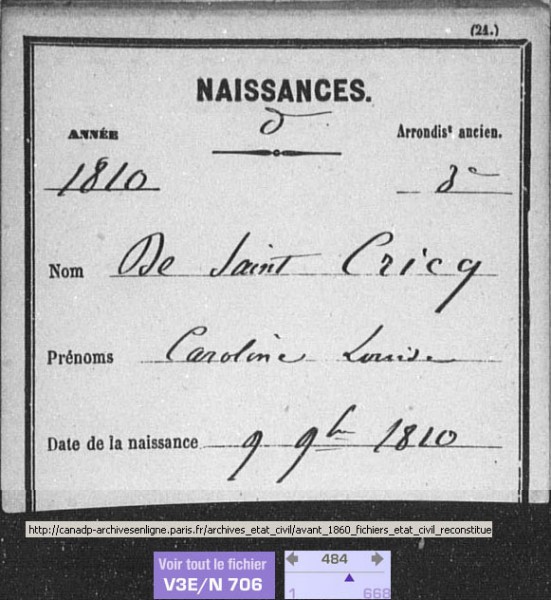 Caroline birth certificate at Paris Archives.
Caroline birth certificate at Paris Archives.
Note that the French 9-bre stands for November
More ambiguity appears if we try to find out what this angelic young girl looked like. Some described her as a plain young girl with brown hair, a pale complexion and mauve eyes (e.g. Léon-Bérard). Others (e.g. Pourtalès, Haraszti, and Dumesnil [22]) describe her eyes as “violet et tristes” and her figure as “of slender frame and angelic beauty”. In 1855, Marie de Sayn-Wittgenstein, daughter of Liszt’s partner Princess Carolyne wrote the following: “She was slender with a distinguished appearance, fine features but a face without vitality. She had dark eyes and black hair […] the whole of her person was filled with the rigidity of someone who was covering up a deeply felt pain.” In his “Letter from a traveler” [23] to George Sand published in February 1837, Liszt compared her to alabaster. We shall probably never know, although a pale complexion and brown hair appear to be true according to the painting depicted in Burger’s biography [24].
Caroline [24] (1828) and her father Pierre [25] (1843)
Notice the facial resemblance
It was Liszt biographer Harsânyi who introduced the nickname “Liline” for Caroline in his books. My research did not show this name having ever been mentioned by Liszt or anyone else in any letters or books. The few letters that mention Caroline all refer to her as “Caroline”, “Mademoiselle Caroline” or “Mme d’Artigaux”. The nickname Liline has not been used by other biographers, so I consider this to be a creative and romantic invention. It may have been used solely between the young lovers. We will never know.
From a young age onwards Caroline was privately educated under the guidance of her mother Clémence. She was an advanced music student even before Liszt taught her. Besides Liszt, she had many other private teachers to train her in all the subjects that a young noblewoman was supposed to master in those days, ranging from the bible, classic and modern literature, to history and the arts. This enabled her to converse knowledgeably amongst the aristocracy. She was taught English, which was unusual among the French nobility in those days. With two elder brothers, this educated and pretty girl must have been the apple of her parent’s eye, they made sure she got only the best of the best and her future life did not include piano teachers.
[1][↑] Key source for this information is the birth certificate from the town of Orthez (to be found at e.g earchives.cg64.fr). Three other sources provide useful data on the Count de Saint-Cricq:
- Assemblee Nationale, Base de Données des Députés Francais Depuis 1789 (to be found at:
http://www.assemblee-nationale.fr/sycomore/fiche.asp?num_dept=13688#mandat_assemblee_nationale); - Robert, G. Cougny, E. Bourloton, Dictionnaire des Parlementaires Français de 1789 à 1889, Paris, 1891;
- Léonce de Brotonne, Les Senateurs Du Consulat et de L’empire 1798-1848, Paris, Charavay, H. Champion, 1887, p. 218.
[2][↑] Member of Parliament, initially for Seine-et-Marne region and from 1820 onward for the Lower Pyrenees region.
[3][↑] De Courcelles, Dictionnaire universal de la noblesse de France, Tome 3 A-M, Moreau, 1821. p. 491.
[4][↑] Death certificate on-line from archives.agglo-pau.fr , Fiche 1E190, view 18/76.
[5][↑] Mémorial des Pyrénées, 42e année, n°25, 28 February 1854, p. 2.
[6][↑] Alexandre Dumas, Impressions de voyage (Le Tour Du Lac), from Oeuvres, written in 1834 and published as Tome premier, Brussels, Meiline, 1838, p 183.
[7][↑] Jules Paulmier, De la justice de m. le comte de Saint-Cricq, ce qu’il a fait, et combien sa, Paris, Trouvé, 1823.
[8][↑] Geneall.fr, French web site of the global Geneall project. www.geneall.net/F/per_page.php?id=1160830
[9][↑] Paris Archives, Fiche V3ED917, p 241. Assemblée Nationale, Loc. Cit. 5, and: C.L. Lesur, Annuaire Historique Universel pour 1828, Paris, Thoisnier-Desplaces, 1829, p. 259. Both sources, as well as her tombstone at Père Lachaise, show June 30 as date of Clémence’s death, so not July 1st as mentioned by some Liszt biographers. The tomb of Caroline’s mother, as well as that of her brother Jules, can be found in section 8 of Père Lachaise, behind Dulong’s obelisk.
[10][↑] There is quite some confusion in this area: in the romantic biography by Zsolt Harsanyi reference is made to Caroline having “brothers”, which presumably means at least two. The document Statistique Generale des Basses-Pyrenees states “one of his daughters married Mr. Dartigaux”, which could mean there also may have been a sister to Caroline. Lina Ramann wrote: “Several sons that she had borne the Count were like their father; their only daughter the youngest of their children resembled herself”. A book on the French Peerage by Albert Révérend states four children, but provides incorrect names. The detailed book Revue de Gascogne states that Pierre and Clémence had two sons and two daughters and lists their names (which are neither correct because they include a cousin). Dates of birth of Caroline and her brothers Jules and Auguste can be found at the Paris Archives.
- Zsolt Harsányi, Immortal Franz: the life and loves of Franz Liszt, Blue ribbon books, 1937, p. 112;
- Charles de Picamilh, Statistique générale des Basses-Pyrénées, Pau, 1858 Volume 1, p 535;
- Lina Ramann, Op. Cit. 4, p. 116;
- Albert Révérend (vicomte), Titres, anoblissements et pairies de la restauration 1814-1830, Paris, H. Champion, 1901, Volume 6, p iii and p. 189. This nobility book erroneously listed Hermine as sister of Caroline and states that she was born in 1822. This error was corrected in an erratum at later versions;
- Revue De Gascogne, Bulletin Bimestrial de la Société Historique de Gascogne, 1890, Volume 31, p 209.
-
Le Comte de Saint Cricq, article in Société des sciences, lettres et arts de Pau, 1954, p 37.
This (hard to find) document states that the Count and Countess had five children, two of which died at early age. Given the fact that the article incorrectly states the decease date of Caroline’s mother this leaves doubt on its accuracy. Additional research at Paris Archives is needed to confirm the birth of Alphonse and perhaps one more child (not found under Cric, Cricq, Criq, Saint Cricq, or De Saint Cricq). - Lycée Napoléon, Distribution des prix faite aux élèves, le dix-sept août 1809, Paris, p 13, 16, 18, 19.
[11][↑] Archives de Paris, L’état civil reconstitué (XVIe siècle-1859), Ficher V3E/N 2009, 401, and:
Livre d’honneur des élèves d’université, Concours Généraux, Paris, Renouard, 1837, p. 177.
[12][↑] Comte Jules de S. Cricq, Notes d’Absence, Paris, Lottin de Saint-Germain, 1821.
Jules writes in his introduction (in 1819) about his younger brother still being at school.
[13][↑] Albert Révérend, op. cit. 14. It appears to have been common practice in the aristocratic Saint-Cricq family to have girls marry at the age of seventeen and marriages between relatives were not shunned.
[14][↑] Charles Yriarte, Paris grotesque: les célébrités de la rue, Paris (1815 à 1863), Paris, Dupray, 1864, p. 63.
[15][↑] L’intermédiaire Des Chercheurs Et Curieux N° 274, Janvier 1974, p. 306.
[16][↑] Paul Bauer, Deux siècles d’histoire au Père Lachaise, 2006, Mâemoire & Documents, Paris, p. 702.
[17][↑] Archives de Paris, L’état civil reconstitué (XVIe siècle-1859), Ficher V3E/N 2009, 402, and: Revue De Gascogne, op. cit. 14.
[18][↑] Journal des Debats, Politiques et Litteraires, Oct. 8, 1822, p.1, Paris.
[19][↑] Le Correspondent, May 10, 1912, Paris, p 483.
[20][↑] Arthur-Paul-Laurent-Marie-Dieudonné de Saint-Cricq (Cte.), Simples Rimes, Paris, de Balitout, Questroy et Cie, 1868, and: Saint-Cricq, Comte, Chants Rapides, Paris, Ernest Loroux, 1879.
[21][↑] Paris Archives, Fiche V3EN706, page 484. Note that, in French, “9-bre” stands for November.
[22][↑] René Dumesnil, La musique romantique francaise, Paris, Aubier, 1944, p 216.
[23][↑] Liszt, “A un Poete Voyageur, Lettres d’un Bachelier Ès-Musique”, Revue et Gazette Musicale de Paris, Feb. 12, 1837, p. 53 (also included in: Franz Liszt / Jean Chantavoine: Franz Liszt, Pages Romantiques, Paris, Alcan, 1912, p. 103).
[24][↑] Ernst Burger, Franz Liszt: a chronicle of his life in pictures and documents, Princeton, University Press, 1989, p. 54. Caroline (1828) and Liszt (1828) pictures included with kind permission by Ernst Burger, Munich, February, 2011.
[25][↑] Pastel with crayon and watercolor of Count Pierre de Saint-Cricq and Bertrand Dartigaux by Eugène Deveria, August 1843 (courtesy Château de Pau Museum archives).

